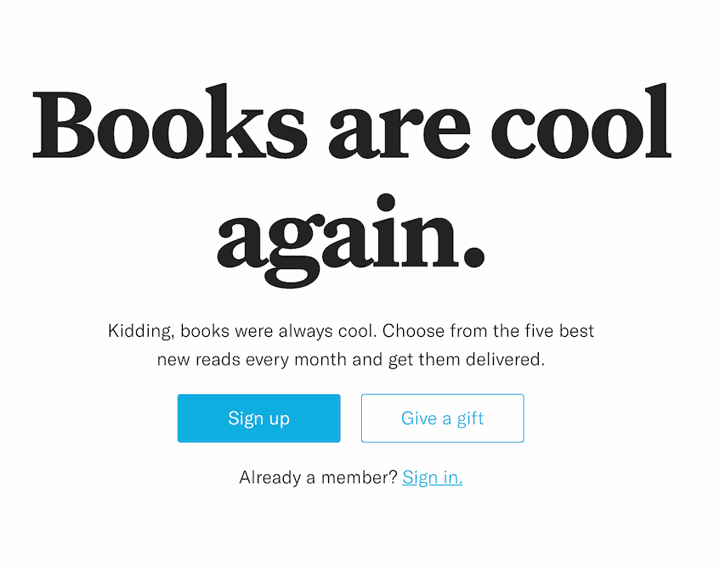Your website is an important part of your business, whether you’re running an eCommerce business or a SaaS startup. This is where your audience will find out about your company, your mission, your offering, and more.
That’s why your website copywriting needs to be strong and effective—on every single page.
Here, we’re sharing seven ways you can improve your website copywriting skills today:
- Write for your target audience
- Set your goal
- Keep it clear
- Stick to active voice
- Make your structure scannable
- Pay attention to microcopy
- Create copy for your web design
Before we jump into those, let’s make sure we’re clear on what website copywriting is in the first place.
What is website copywriting?
Website copywriting is the process of creative action-driving copy for a web page. This includes lots of different places, including your landing pages, content marketing, social media posts, product descriptions and—perhaps most importantly—your homepage.
Take this example from Peloton.

This text is persuasive and concise, and it’s all driving users to a single call to action (cta): signing up for a trial. That’s effective website copywriting.
How to make your website copywriting effective
Now, let’s go through seven ways you can improve your website copywriting and make it work well. Because website copywriting that performs means a higher conversion rate, more sales, and more business for you.
Here we go.
1. Write for your target audience
In order to write anything well, you need to know your audience. If you’re writing for a class, it’s so much easier to know how to write if you know who’s grading your paper. An email to your mom? Way different than an email to your boss. I mean, this is the case even when you’re signing an office birthday card—it’s hard to write a nice message for the guy who sits at the end of your cube row when you only ever say good morning to each other.
So to write effective copy for your website, you need to know your target audience and keep them top-of-mind when you’re working on this. The best way to do this is to keep your buyer personas handy.
If you don’t have these, buyer personas are detailed profiles of people who represent your target audience. These often include age, job title, and background. But they also include likes and dislikes, as well as frustrations and motivations.
With your buyer persona in mind, you can use your website copywriting to speak directly to your audience. Here’s how Book of the Month does it.

Originally founded in 1926, Book of the Month rebranded a few years ago as a trendy book subscription company for modern-day readers. This website copy reflects that—they’re talking to people who are already readers, and they’re inviting them to join a like-minded community.
2. Set your goal
All kinds of copywriting are action-driven. That means you’re writing text that encourages users toward a goal, whether that’s to purchase your product, sign up for a newsletter, or start a trial.
But to direct users toward an action in your website copywriting, you need to set that goal. This will depend on the page and your business model. For eCommerce sites, you’ll likely be focused on driving sales. For B2B, you’re probably going to focus on email sign ups or trials. For apps, you’re looking for downloads.
Dollar Shave Club is an online store that offers a subscription service that provides high-quality razors to customers based on their needs, and their website home page explains while encouraging users to get started.

The headline copy “Tell us how you get ready” prompts the customer to engage with their company, and the subheading using the phrases “customize a box” and “just for you” communicates the personalization they offer to customers.
3. Keep it clear
Reading an entire web page and still having no idea what a company does is frustrating. Don’t let your visitors—worse, your potential customers—feel that way.
Instead, keep your website copywriting clear and to the point. As a rule of thumb, try to only use short sentences. Landing pages should showcase the value proposition you offer and let the user know what happens when they become your customer. Product pages should include descriptions of your products, the benefits and the features. And your homepage should explain exactly what your company sells—and how it benefits users.
Drizly is a great example. Their homepage copy leaves no room for misinterpretation-- The company is an eCommerce website that offers quick alcohol delivery to customers.

When you’re writing copy, especially with eCommerce copywriting, being engaging is great, and so is being clever for the right audience. But it’s important that whatever else you do, you’re always being clear.
4. Stick to active voice
This is a great way to keep your website copywriting clear. Avoid using the passive voice in any of your constructions, and instead stick to the active voice.
Let me explain these sentence structures. Passive voice occurs when the subject receives the action. Here’s an example: This blog post was published. Blog post is the subject, and published is the verb. Who published it, though? That’s not always clear in the passive voice.
Active voice, in contrast, occurs when the subject of the sentence performs the action. Take a look: Unstack published this blog post. Here, Unstack is the subject, and it’s doing the publishing.
Much clearer, right?
Here’s how this looks in copy. Klaviyo does a good job of keeping its website copy nice and active.

Check out all those verbs calling for you to take action—to listen, to analyze, and, literally, to act. Active voice helps with keeping your copy clear, and it’s also more engaging for the reader. Win, win.
5. Make your structure scannable
Because you’re a person who looks at the internet, you’re probably already aware that people don’t usually read website copy from start to finish. Studies show that 79% of people scan website copy without reading any page word-for-word. That’s why big blocks of text on a website just won’t work. No one is ever going to stick with you long enough to get through all the information.
With website copywriting, you need to plan on that. That’s why making your layouts super scannable from the get-go is so important, whether you break up your copy or use bullet points, its important to avoid big blocks of text at all costs.
You can make your website scannable by placing images or videos strategically and using headings and subheadings to organize your copy. Here’s an example from Toast.

The heading of this section makes it clear what’s going on in the copy—these are reasons why so many customers love working with Toast. The subheads are the reasons, and the copy underneath that explains why. But you don’t need to read that copy to get the meaning. Scanning the headings conveys all the information you need to understand what’s going on here.
6. Pay attention to microcopy
Microcopy is the term for the small print that explains or prompts an action. This often falls under UX writing, especially when it appears during checkout, in your email marketing campaigns, and on your product landing pages.

The text in the red box is microcopy.
This is an example of microcopy during check out, but it also appears on web pages. Think your calls to action, drop-down menu copy, and that small text about terms and conditions. When you’re working on website copywriting, you need to pay attention. Microcopy is a great opportunity to improve your user engagement or use your brand voice.
7. Create copy for your web design
Ideally, you’ll come up with your website copy and your design together. A concept for the look and feel of the website and the goal of the page will come first, and then you’ll coordinate design and copy to support that.
But that's the best case scenario, and marketing projects rarely avoid any bumps or changes. So planning on creating your copy and your concept before your web design is a good bet. That way, you can still make sure the copy works with the design for a cohesive, elevated experience.
When you can create this experience, your website copywriting is even more impactful. I don’t know about you, but I have a great friend who has sent the best Paperless Post invitations to our special occasion Zooms over the last year. Their website is a great example.

See that copy that describes the company’s evites for “the moments that matter”? This background video and the example invite in the center are for a baby shower, clearly a moment that matters. But then the background changes.

There’s this bar mitzvah, a wedding, and more that cycle through as video backgrounds. That kind of connection between the website copy and the design gets people engaged and keeps them on your site longer.
Improve your website copywriting
Remember to keep these in mind when you’re working on your website copy. And while you don’t need to follow all of these in every single headline or call to action button, these tips aren’t mutually exclusive. You can stick to active voice while focusing on benefits in a nice, scannable structure. In fact, these tips work best when you’re using them all together. So treat this like a checklist to overhaul your copywriting today.
